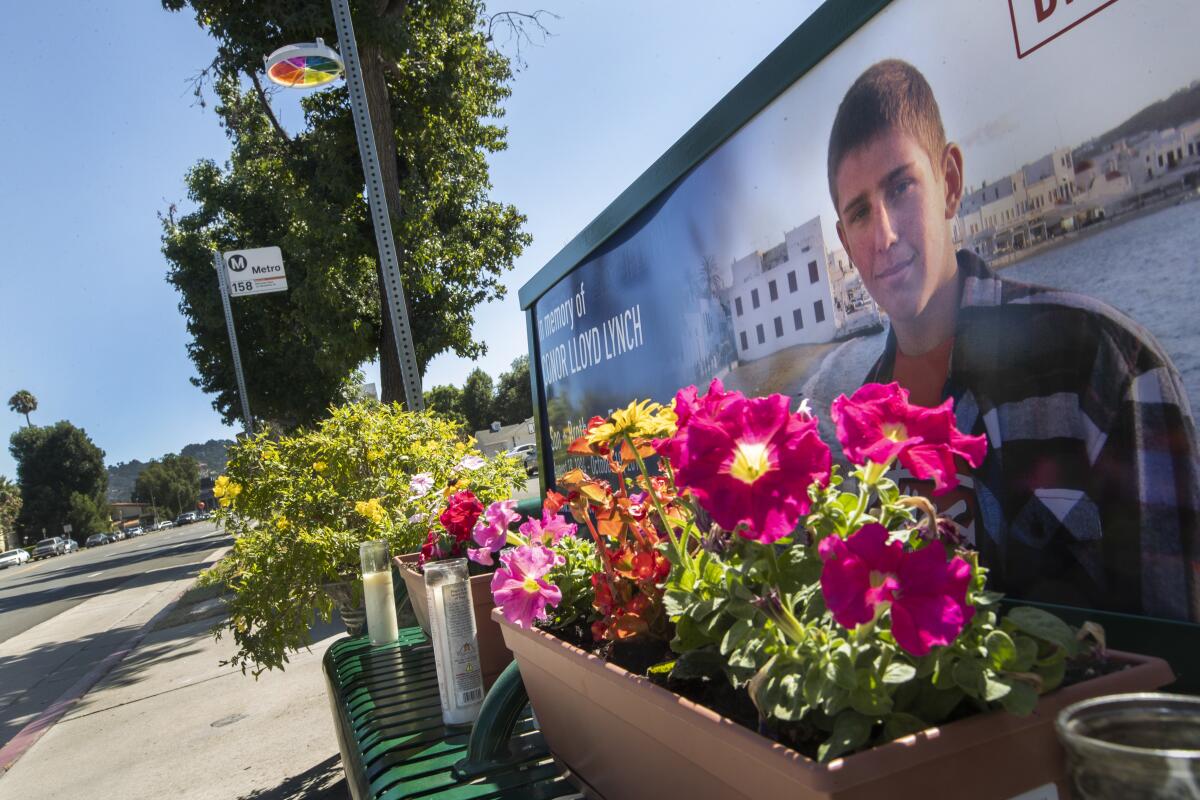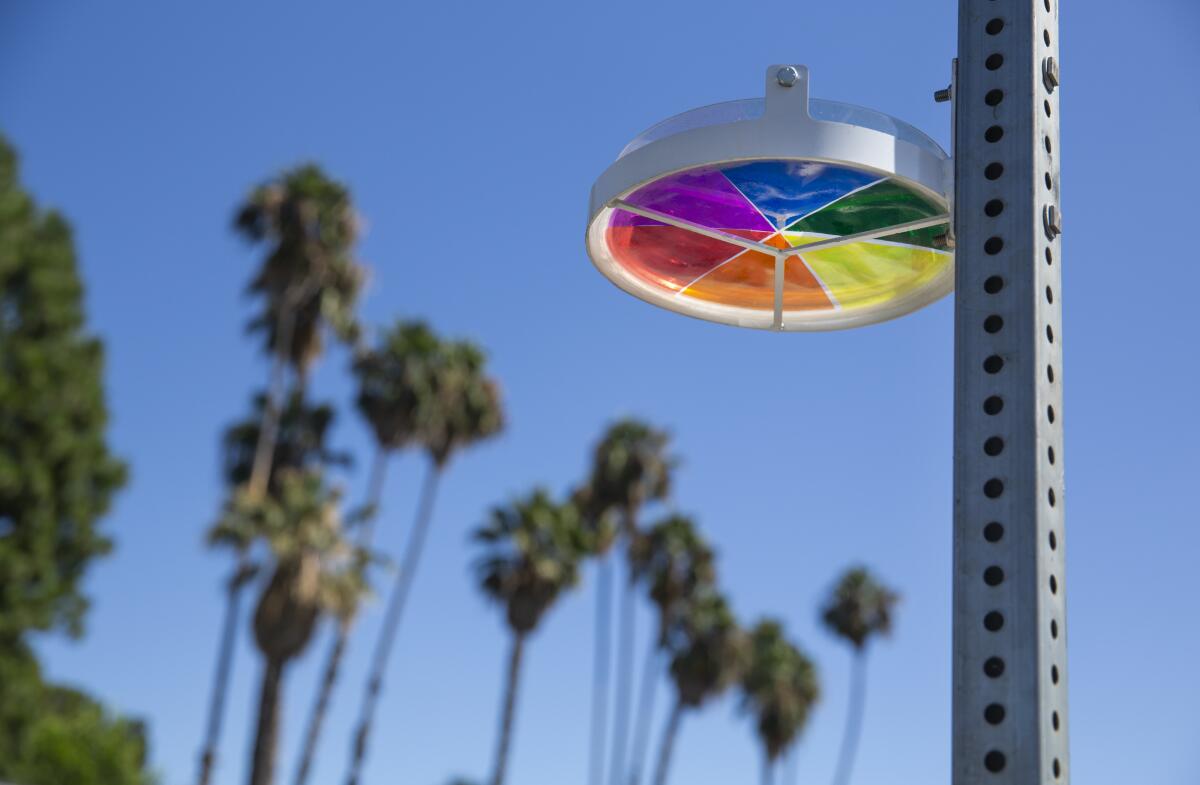100 rainbow ‘halos’ on Los Angeles street corners will honor people killed in car crashes

- Share via
On a fall afternoon in 2010, 16-year-old Conor Lynch was struck and killed by a driver as he ran across a street in Sherman Oaks to catch up with his high school cross-country team.
Nearly a decade later, the intersection where he died has a new feature: a vivid, multicolored disc, about the size of a dinner plate, that casts a rainbow shadow across the pavement and a green bus bench that bears his photo.
The memorial, called “Rainbow Halo,” is the first of 100 to be installed at intersections across Los Angeles where drivers, pedestrians and cyclists were killed in traffic collisions. Each memorial will include a rainbow disc and a plaque, designed to raise awareness about traffic safety.
“You’ll never see the light come through in the same way twice,” Conor’s mother, Jeri Dye Lynch, said of his memorial. “You can have this beautiful rainbow, and the next moment, it fades. It shows the fragility of every moment.”
The public art project is part of Vision Zero, Mayor Eric Garcetti’s initiative to eliminate traffic deaths on Los Angeles streets by 2025. The program, which began in Sweden in the 1990s, teaches that every traffic death is preventable through better education, enforcement, behavior or street design.

In Los Angeles, Vision Zero has not met its early benchmarks. Fatal car crashes rose 32% between 2015, the year Garcetti launched the program, and the end of last year. The number of collision deaths fell slightly over the last two years, which officials attribute to new street safety projects.
This year, the number of fatalities stands at 149 as of Aug. 24, a 1% reduction from the same time a year ago, the Los Angeles Police Department said.
The Rainbow Halo project began in L.A.’s artist-in-residence program, which aims to change the perception of the city’s streets by placing artists in the Transportation Department.
A previous artist’s work included outfitting a Mar Vista bus stop with a device that dispensed custom perfumes, including “economic development” (lavender, with a hint of coffee) and “Hollywood springtime” (flowery but forgettable).
The halos are creating “a site of collective memory, bringing attention to it in a way that gets people to stop and to think,” said Danielle Brazell, the general manager of the Department of Cultural Affairs, which oversees the artist-in-residence program. “That’s the first step in changing behavior.”
The halo concept was proposed by artist John Morse, who is perhaps best known for his work with New York City transportation officials on a traffic safety campaign.
In 2011, he installed brightly colored posters on street signs across the city, each with an accompanying haiku. One read, “Oncoming cars rush / Each a 3-ton bullet / And you, flesh and bone.”
Eventually, there will be 100 halos. After Lynch’s memorial was installed, city crews added halos at crash sites in Sunland, Vermont Square and Del Rey. Others are planned in Frogtown, Shadow Hills, Wilmington, Silver Lake and Carthay. At some intersections that have seen multiple deaths, the halos could honor several people, officials said.
Morse said he spent four years perfecting the halo design. Each is a glass dish with pie-shaped wedges of rainbow gels, like those used in theater spotlights, attached to the outside. The interior is half-filled with mineral oil, leaving enough air for ambient light to filter through and onto the ground.
The halos are being being manufactured for $200 each by a city contractor, Transportation Department spokeswoman Connie Llanos said. To keep installation costs down, the halos are being added to street corners when other work is scheduled in the area, she said.
The roadside memorial concept recalls the white “ghost bikes” that friends and advocates have long placed at the scene of crashes that killed bicyclists. But the halos will also honor car passengers, drivers and pedestrians.
“When someone is killed, it’s a momentary flash in the news,” said Samuel Chu, who works with Southern California Families for Safe Streets, a project of Los Angeles Walks. “People never know that there are years and years of difficult injuries and recoveries, of legal ramifications, years and years of grief, that never get told.”
Too often, he said, opponents are the only non-city employees that Los Angeles residents meet in connection with Vision Zero projects. That, he said, has for a long time been a void in the city’s messaging strategy.
The art effort has sparked criticism from some advocates who say the city should spend the money and effort on more changes to streets that encourage drivers to slow down and put away their phones.
“Any time you can get anybody to pause, and ponder, you have advanced your goal,” Morse said.
More to Read
Sign up for Essential California
The most important California stories and recommendations in your inbox every morning.
You may occasionally receive promotional content from the Los Angeles Times.














